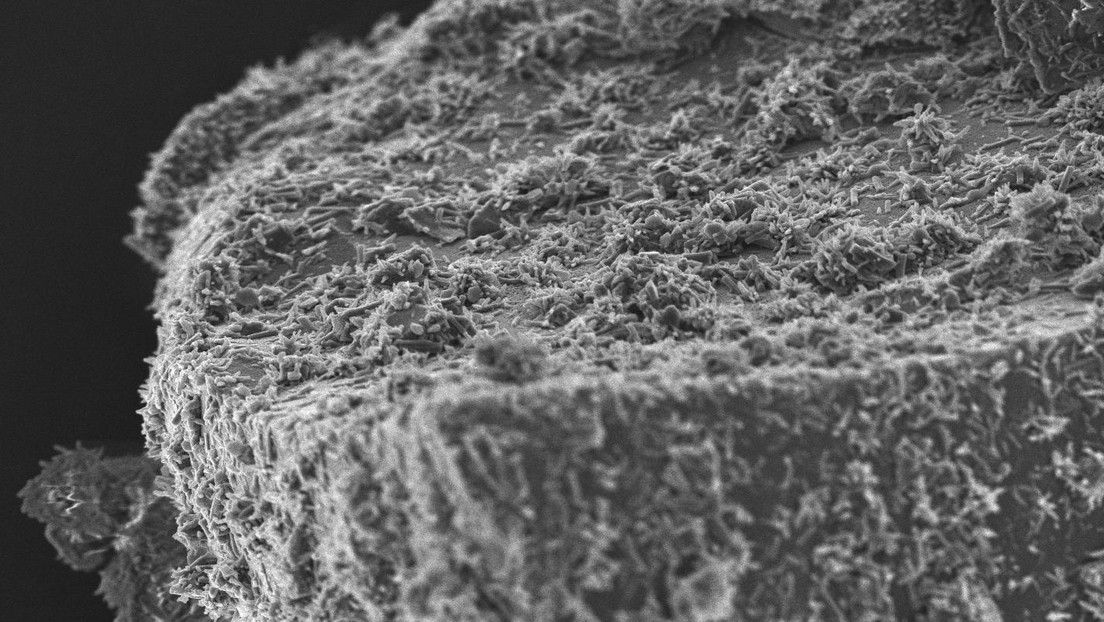
© 2017 EPFL Electron microscopy image of calcium silicate hydrate, the main cement hydration product
An international team of researchers from EPFL, ETHZ and Rice University in Houston creates a database tool for the design of cement, a component of concrete, the most-used construction material in the world and a significant source of atmospheric carbon dioxide. The database contains validated atomistic models for molecular modeling that could help fine-tune cement and curtail emissions. This could make cement manufacture greener and more efficient.
The database is called cemff, for Cement Force Fields. It gathers methods for simulating force-field parameters for the various types of inorganic minerals present in cement, which is used to bind concrete, the most-used construction material in the world. In this case, the force field is the collection of parameters scientists use to build computer models of atomic interactions. These parameters include the intrinsic energy of the atoms in a simulation system. They are used to calculate how atoms interacts individually and collectively with their neighbors to give the material its properties. Cemff allows academic and industrial researchers to draw upon many types of force fields to make accurate simulations and predictions of purpose-built cement formulations. Fifteen scientists at 11 institutions worked on the project led by Paul Bowen of EPFL, Ratan Mishra of ETHZ and Rouzbeh Shahsavari of Rice. Details appear in the Elsevier journal Cement and Concrete Research.
Building a more sustainable material
“I hope the open format and international base of the cemff database will encourage both the modeling and experimental community to create solid benchmarks to help understand and predict more accurately the properties of the most used material on Earth and help us build a more sustainable future,” Bowen said. Cemff could help industry design stronger, more durable construction materials that also curtail carbon dioxide emissions from the manufacture of more than 3 billion tons of cement and concrete a year. Concrete manufacturing contributes as much as 8 percent of the greenhouse gas to the atmosphere. “This unified database is in line with the current trend towards big data and predictive computational materials science,” said Shahsavari, an assistant professor of civil and environmental engineering and of materials science and engineering at Rice.
Simulations at nanoscale
Cement consists primarily of calcium silicates that react with water to produce the hardened material that confers mechanical properties and durability to concrete. It was found that nearly 60 percent of carbon dioxide emissions from cement production comes from the decomposition of limestone, the source of calcium in cement, but also of carbon dioxide emissions. To reduce the carbon footprint, manufacturers often supplement the mix with clays, waste materials like fly ash and recycled materials. The models show how the component molecules in cement interact with each other. These microscopic interactions determine how well concrete performs in real-world applications and allow for fine-tuning the material to perform at its best for decades and in the most environmentally conscious way. These all influence the mechanical characteristics and resilience of the product. Hence the need for simulations at nanoscale that let manufacturers test mixes for strength and durability even before making real cement. “Molecular modeling still requires multiple trade-offs,” said Mishra, lead author of the paper and a materials scientist at ETHZ. “The typical example is time versus accuracy but, more importantly, it is essential to recognize what specific models are good at and what they may be challenged with. Cemff will allow researchers to have a more comprehensive view on this question and to select the best approach for the problem they are tackling.”
Authors of the paper include Aslam Kunhi Mohamed and David Geissbühler of EPFL Lausanne; Hegoi Manzano of the University of the Basque Country, Bilbao, Spain; Tariq Jamil and Hendrik Heinz of the University of Colorado Boulder; Sandra Galmarini of the Swiss Federal Laboratories of Materials Science and Technology, Dübendorf; Lei Tao of Rice; Roland Pellenq of the Massachusetts Institute of Technology; Adri van Duin of Pennsylvania State University; Andrey Kalinichev, a professor at the Mines-Télécom Atlantic Institute, Nantes, France, and a fellow the National Research University Higher School of Economics, Moscow; Stephen Parker of the University of Bath, United Kingdom, and Robert Flatt, a professor of civil, environmental and geomatic engineering at ETH Zurich.
The research was supported by the Commission for Technology Innovation, the National Science Foundation, the Swiss Competence Center for Energy Research-Supply of Electricity, the Department of Education, Linguistic Policy and Culture of the Basque Government, the ELKARTEK program, the Swiss National Foundation, the Nanocem research network, the ACS Petroleum research fund and the Mines-Télécom Atlantic Institute.
Access cemff at http://cemff.epfl.ch
Author: Clara Marc Source: Mediacom